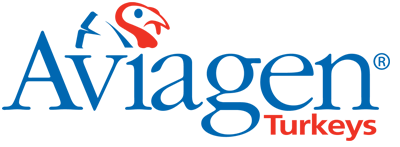John H Ralph
Aviagen Turkeys Ltd, Chowley Five, Chowley Oak Business Park, Tattenhall, Cheshire, CH3 9GA
[email protected]
Primary breeders make a valuable contribution to the environmental sustainability of turkey production. Although the environmental impact of turkey production relative to other protein sources is favourable, there is an increasingly strong case for all meat production to improve resource use and reduce environmental outputs. Evaluation of biological performance over time and expected progress in turkey genetics shows considerable improvements in both practical measures of resource use as well as outputs from life-cycle analysis (LCA). It is clear that flock feed utilisation efficiency represents the greatest opportunity to reduce the environmental impact of turkey production. Ongoing investment in breeding technologies will further enhance rates of improvement in Feed Conversion Ratio (FCR) and consequently the environmental footprint of turkey producers.
To be successful, primary breeders must adapt to changing market needs and translate these needs into breeding goals. Ultimately it is the consumer who decides whether turkey will feature on their menu. In recent years, there has been a shift in consumer attitude from more traditional drivers such as price, convenience and taste to evolving drivers such as health and wellness properties of the produce and its social impact (Ringquist et al., 2015). Transparency is increasing in importance as consumers want to know more about their food and how it is produced.
An illustration of the types of societal concerns can be seen in a recent survey of meat-eaters who are giving up meat (YouGov, 2019), here animal welfare, health and environmental concerns are cited as the key reasons. This is a sign that consumer perceptions around the sustainability of the meat production supply chain can have an impact on dietary choices.
The spotlight on the resource footprint of animal protein supply is expected to intensify in 2020 and increasingly so as we head towards 2030, the benchmark year to achieve a number of global Sustainable Development Goals (SDG) set out by the United Nations, including greenhouse gas emissions (Rabobank, 2019). The International Poultry Council has demonstrated the Poultry Meat Sector’s commitment to sustainable development by formally adopting 5 key SDGs in the joint FAO-IPC Declaration of São Paulo. Primary breeders have a strong contribution to make in helping to achieve these goals:
1. Zero Hunger (SDG2)
Health, food safety and food security are required. Positioned at the start of the global turkey supply chain, breeders must operate high biosecurity facilities, replicated across multiple locations to ensure continuous delivery of breeding stock free from salmonellas and mycoplasmas. Further, genetic improvements in the economics of turkey production continues to make turkey meat a widely affordable protein source.
2. Industry innovation and infrastructure (SDG9)
Breeders must maintain a diverse range of genotypes to cater for changes to market needs. These populations would include pedigree lines used in current breeds as well as a range of alternative lines of diverse genotypes all of which must be managed responsibly to minimise inbreeding levels and selected using the latest selective breeding technologies.
3. Climate actions (SDG13)
Application of balanced breeding allows simultaneous improvement across a wide range of traits to deliver improvements in production, health and welfare traits. This paper shows the value of genetic selection to reduce the impact of turkey production on climate change.
4. Quality Education (SDG4)
Genetic improvement creates opportunities for long term, permanent and cumulative improvements in flock biological performance. Maximising genetic potential requires research and development of technical advice as well as on the ground support from the primary breeders.
5. Good health (SDG3)
Transparency, communication and engagement. Breeders play an important role with customers, associations and wider society, reviewing and addressing the concerns of society and sharing information about what is being done to improve turkey production.
Societal pressure to reduce resource usage is expected to intensify as a result of global population growth combined with competition for arable land use (feed, food, and fuel competition) and the effect of climate change. Fortunately, poultry production is starting from a good base, being a relatively efficient user of animal feed, using less arable land and having lower greenhouse gas emissions than other protein sources (Figure 1). However, although much of the attention is currently on the impact of red meat, there are many examples in the media where poultry meat is not clearly distinguished.
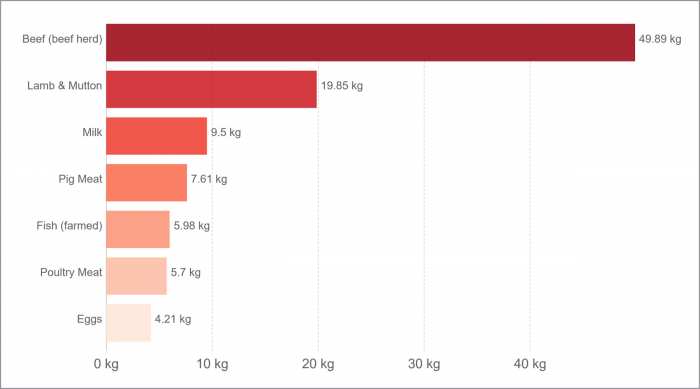
The biological performance of turkeys has improved over time. This can be seen from performance objectives published by breeding companies. The performance objectives (PO) of the B.U.T. 6 can be traced from 1977 through to 2020. These represent achievable top quartile performance and provide an estimate of the realisable genetic potential of the breed over time. We estimated the environmental impact of performance changes combining historical PO data with predictions of future performance up to 2023 (committed) and 2030 (planned, subject to market requirements) (Table 1).
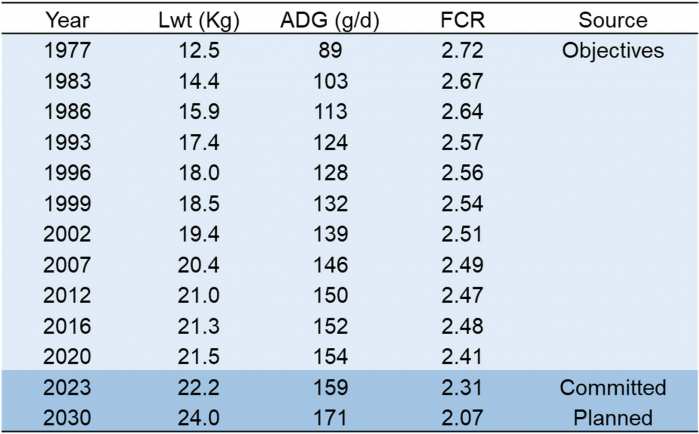
Field results from European producers substantiate the improvements shown in performance objectives. Of particular interest is the trend in B.U.T. 6 liveability being seen in Europe which has improved considerably in recent years and all the more impressive given the backdrop of reducing use of antibiotics (BVL 2019, BPC 2019).
Assessing sustainability improvements arising from genetic progress in turkeys
Calculations of benefits arising from current rates of genetic progress for FCR, weight, water consumption, liveability and processing yields show substantial annual improvements on practical resource usage, contributing significantly to sustainability of the turkey sector (Table 2). These effects are cumulative over time.
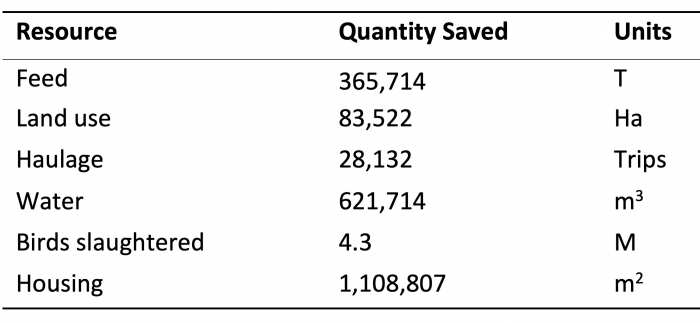
Assessment of the environmental impact of genetic progress in turkeys was made using the turkey specific LCA model developed by an industry–academia collaborative research project supported by the UK Technology Strategy Board. This LCA model calculates farm level environmental impacts. The model utilises information from typical UK productions systems and raw materials to calculate the main environmental impacts (including carbon footprint) per kg live weight and carcass weight using input data given by the user (e.g. bird performance, feed composition, energy use) (Leinonen et al., 2016).
The turkey LCA model was used to estimate the environmental impact of historical and projected changes in BUT6 performance (Figure 1). The results show that from 1977 to 2020, an improvement of around 0.35% to 0.65% per annum across all environmental indicators. From 2020 onwards, estimated progress is in the region of 1-2% improvement per annum depending on environment, nutrition, management and health factors (Figure 2).
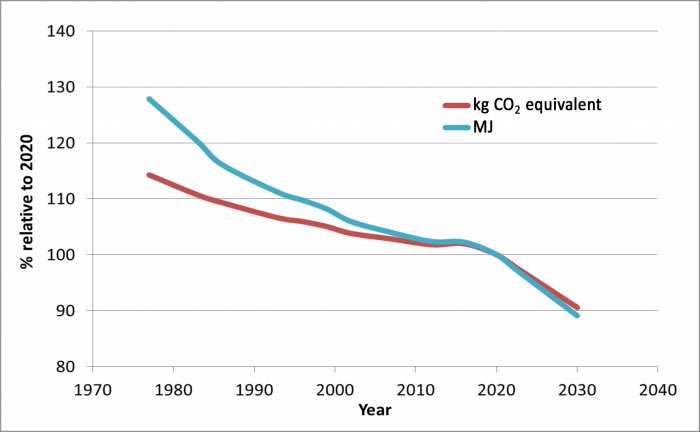
Analysis of genetic progress in each individual trait shows clearly that annual improvement in FCR accounts for around 70% of the improvement across all the environmental measures followed by weight and the liveability. This agrees with work by Jones (2008) which confirms the dominant effect of FCR improvement in turkeys on global warming potential.
Flock FCR is a function of individual bird efficiency, bird liveability and vitality associated factors such as robustness, gut health, diseases resistance, leg health and weight. Many facets of the breeding programme contribute to improvements seen in flock level FCR, 2 key strategies are highlighted below.
Selection for individual feed efficiency has moved from cage based individual FCR assessment to transponder based lifetime FCR measurements where birds are housed in a group environment with activity and social interactions akin to regular commercial production and as a result this delivers enhanced rates of progress. Aviagen Turkeys has been exclusively selecting for FCR using this methodology since 2006 for all pedigree lines contributing to current commercial breeds and since 2018 has invested to increase testing capacity by 50%.
Multi-environment selection has been instrumental in improving flock robustness and gut health as it allows breeders to utilise information from different environments in the selection of pedigree candidates. At Aviagen Turkeys information from the highly biosecure facilities, where birds express good growth potential, is combined with information from siblings grown in less biosecure facilities where birds are exposed to more challenging conditions simulating those that can be experienced by commercial turkeys out in the field.
In addition to the above, genomic selection has been incorporated into the breeding program since 2017, further enhancing the rates of genetic progress in FCR and related traits.
Avec (2018) Annual Report.
BPC (2019) British Poultry Council Antibiotic Stewardship Annual Report 2019. www.britishpoultry.org.uk/download/bpc-antibiotic-stewardship-report-2019/.
BVL (2019) Bundesamt für Verbraucherschutz und Lebensmittelsicherheit. Bundesweite Kennzahlen zur Therapiehäufigkeit bei Masttieren (publications from 2015-19).
Jones (2008) A study of the scope for the application of research in animal genomics and breeding to reduce nitrogen and methane emissions from livestock based food chains. Appendix2. DEFRA Project AC0204.
Leinonen, I., Williams, A.G.,Kyriazakis, I. (2016) Comparing the environmental impacts of UK turkey production systems using analytical error propagation in uncertainty analysis. Journal of Cleaner Production 112:141-148.
Poore, J., & Nemecek, T. (2018) Reducing food’s environmental impacts through producers and consumers. Science, 360(6392), 987-992.
Rabobank (2019), Global Animal Protein Outlook 2020.
Ringquist, J, Phillips, T., Renner, B., Sides, R., Stuart, K., Baum, M., Flannery, J., (2015) Capitalizing on the shifting consumer food value equation. Deloitte.
Ritchie, H., Roser, M. (2020) "Environmental impacts of food production". Published online at OurWorldInData.org.Retrieved from: ourworldindata.org/environmental-impacts-of-food.
YouGov, (2019) Is the future of food flexitarian? YouGov analysis of Brits’ dietary habits and attitudes to meat consumption. campaign.yougov.com.
